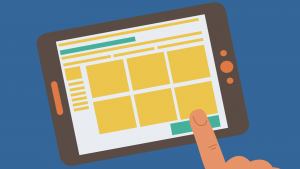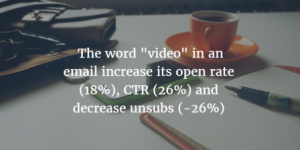We are all human and looking for opportunities to connect, learn, and grow together. In the current state of the world, many companies are unable to lean on traditional in-person events as they normally would to generate leads. The result: Customers are yearning to forge connections, and companies are looking for new ways to fill a potential void in their sales funnel.
According to ZoomInfo, “73 percent of B2B marketers and sales leaders say webinars are the best way to generate high-quality leads.” When done the right way, webinars are a tremendous opportunity to supplement that face-to-face experience and fill your pipeline with qualified leads.
Unfortunately, it’s not that easy. Webinars have become a dime a dozen, so now more than ever it is crucial that you find a way to stand out when hosting online programs.
Considerations When Hosting a Webinar
Here’s the reality: people are exhausted, and many suffer from content overload. We are living in a world where webinar and technology fatigue is more real than ever. This shouldn’t deter you from hosting online events, but it certainly should be a consideration as you put your program together. After each webinar, be sure to assess the effectiveness of your webinars, and pivot when you see the signs of fatigue.
As you prepare to host a webinar, remember that at the end of the day this webinar is about delivering value to your viewer. The more value you can provide, the more they will feel this was worth their time, and they will feel a more positive association with your brand.
Put yourself in your viewer’s shoes. Ask yourself questions such as the following to ensure you deliver optimal value with your webinar:
- What is the desired outcome of this webinar?
- How can I ensure this program is worth their precious time?
- What will keep them engaged and inspired from beginning to end?
- How can I provide an opportunity to build bridges and create connections between participants?
- How does my viewer best process information? Are they a visual, hands-on, or auditory learner?
The more questions you ask upfront, the more you’ll empathize with your viewers and be able to serve up programming that is most beneficial to them. This is the difference between a good webinar and an amazing webinar.
Live Webinar Strategies to Stand Out in a Webinar-Saturated World
Consider these strategies as you plan your next webinar so you can wow and delight your audience, and keep them coming back for more.
Experiment with forum type
“Webinars” don’t always have to mean lecture-based PowerPoint presentations. In fact, listening to a speaker for one hour without a break isn’t usually the way people learn best. According to Stanford University, “most successful adult learning takes place in a collaborative or cooperative setting, where sharing and synergy are crucial.”
There are a number of ways to leverage webinar tools and turn these forums into opportunities for collaboration. Consider hosting more exclusive online events and invite a smaller group of individuals. These can become ideation sessions, bootcamps, classes, roundtable discussions, or even “fireside” chats with an industry expert.
You can use tools such as breakout rooms to divide your audience into even smaller cohorts so they can collaborate together on a given idea. Or take it one step further, leveraging the whiteboard feature to give people a visual way to workshop and learn together.
Interact with the audience
This sounds elementary, but there are a number of simple ways to leverage technology to interact with the audience. You can use tools such as Zoom and GoToWebinar to launch polls. In addition to polls, experiment with launching surveys or have a co-host run an ongoing Q&A through the chat functionality. Adding an interactive element, especially toward the beginning of the webinar, will quickly engage participants.
Here’s an out-of-the-box idea: With a smaller number of attendees, try playing around with an icebreaker activity—try something like a virtual scavenger hunt. How does it work? Prompt attendees to search their house or office for a given object (e.g., their favorite business book), and the first person back to their computer with the item wins a gift card.
Take “offline” concepts “online”
Certain industries that lean more heavily on in-person and face-to-face interactions to seal the deal in their sales process. Think about senior care facilities, colleges and private schools, and other companies that thrive off of giving in-person demos of a product or service.
Now think about how those in-person engagements can translate into live online forums. We’ve seen senior care communities leverage webinars to showcase their team members as panelists, hosting Q&As and giving attendees a feel for the facility right from the comfort of their home. Product-based companies have created virtual showrooms that act as online forums to demo a product and ask questions. There are other service-based organizations, such as HubSpot, who replaced in-person classes with interactive virtual bootcamps to engage potential clients.
Tie online concepts back to offline. One thing you miss with online events is the ability to give someone a physical takeaway (e.g., brochure, swag, gift box). If you are hosting an open house for prospective college students, for example, send attendees a gift box before the webinar and encourage them to post on social media. People will appreciate the gesture, and it’s added brand recognition for your team.
Add surprises into the mix
People are accustomed to traditional webinars—sit down, headphones in, listen to a 40-45 minute presentation, and then have time at the end for questions. Where’s the “wow” factor in that? Not only is there no “wow,” but with that approach you are more apt to lose attention. On average, 10 percent of your participants will drop out before the program is over.
There are a number of ways to keep your audience stimulated—and one big way is to incorporate the unexpected. On a small scale, make sure you have a balance between text and visuals. Add relevant (and fun) videos and gifs throughout the presentation so you give viewers something new to look at. Just make sure you test your audio and technology first, if you will be playing sound.
Other out-of-the-box ideas include taking a mindful breath with your audience somewhere in the middle of the program or playing a clip of a song to cue a new section. You could even line up a surprise special guest speaker to join the program halfway through (and hype this up at the beginning of the webinar).
Don’t be afraid to stand out
We already established that we are seeing a lot of webinars out in the market. With that in mind, you’ll also want to think about how you stand out with the promotion of your webinar, starting with naming conventions. Is webinar the best descriptor of your program, or is there something else of value to your audience?
Substitutes for the word “webinar” may include, but are not limited to:
- Bootcamp
- Series
- Roundtable discussion
- Open house
- Fireside chat
- Masterclass
- Virtual tour
- Simulated product demo
Bonus tip: Don’t be afraid to promote your live event as “exclusive,” so people know that it may not be recorded. People love to be a part of something exclusive and won’t want to miss out.
You have all the technological tools you need to have a stand-out virtual event for your audience. The ultimate key to your brand’s event success is being creative and agile in your approach. One of the most positive by-products from the pandemic are the creative solutions companies have been putting into place to help their brands flourish. Look around for inspiration, and continue to empathize with what your audience needs from you right now. If you keep your eyes and mind open, you will be sure to have a successful webinar.
Business & Finance Articles on Business 2 Community
(17)






